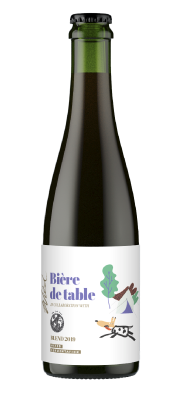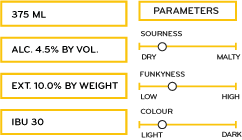 |
 |
WILD No. 8 Bière de TableWe proudly present our eighth beer from the WILD brand – Bière de Table, brewed in collaboration with Little Earth Project back in November 2019. Co-fermented with our own mélange of wild yeast and Little Earth’s house strain, harvested from skins in apples from their own farm in Sudbury, UK
|
Malts:
Multigrain base, with a decent amount of flaked Oats.
Hops:
Brewed with our all time continental favourite Tettnanger tettnang for bitterness and aroma and a bunch of Mosaic in Whirpool.
Fermentation:
Primary fermented in Steel with an expressive Belgian strain.
Secondary in neutral oak barrels with our own wild yeast and Little Earth’s wild yeast mélange.
Blended with 10% of our most acidic barrel aged Mixed fermentation Saison.
Changes over time:
Time is extremely important for those kind of beers, because the microorganisms that take part in their production ferment slowly. That is why we leave them in barrels for several months so that they take on their extraordinary character.
This beer remains alive – it is not pasteurized, but refermented in a bottle. This means that even after filling, microbes ferment – saturating, protecting and changing beer character all the time.
We recommend drinking this beers fresh, but stored in the right conditions (cool and dark) they can be consumed much later. Note that this beer is probably going to be different consumed fresh or aged – it develop and constantly changes with the time!
Serving tips:
Beers of this type are highly saturated, therefore they should be served in the right way:
1. Serve well chilled
Like sparkling wines and champagne, our WILD beers taste best when cooled properly before opening – we recommend storing them vertically at 4 to 6 degrees for about 24 hours before opening!
2. Be careful
The pressure inside the bottle caused by refermantation is definitely higher than in beers not subjected to this process and can be comparable to champagne – so be careful when opening!
3. Hold and pour at an angle
Holding the bottle at an angle when opening increases the surface of the liquid in the neck of the bottle, thanks to which the pressure releases more freely minimizing foaming. Transfer to glass should also be at an angle to reduce the loss of dissolved carbon dioxide and prevent excessive foaming. Beer should be poured without any natural yeast precipitate that can accumulate at the bottom of the bottle.
- Style: Table Beer
- Parameters:
- Extract: 10,0 %
- Alcohol: 4,5 %
- IBU: 30
- Ingredients: water, malt, flakes, hops, yeast
- Malts: barley: Pilsner; rye and wheat malt; oat flakes
- Hops: Tettnanger, Mosaic
- Yeasts:
- House Belgian strain and Brett mélange. Little earth’s house wild yeast.
- Appearance: straw yellow, slightly hazy with a creamy long lasting head.
- Aromas: really flowery, elderflower, herbal, ripe passion fruit
- Mouthfeel:
- Medium up to high carbonated, easy drinking yet full
- Serving temperature: 5-7⁰C
- Glass: Tulip, Snifter, Stange or Flute (choose which one you like best – Tulip and Snifter will intensify the aromatic sensations, while Stange or Flute will reduce them a bit)
- Foodpairing:
- Dishes: herbal salad with crispy chicken and lemon balm vinaigrette
- Cheese: rennet cheese with herbs, goat cheese
- Dessert: rustic pie with rhubarb and crumble, thai ice creams

